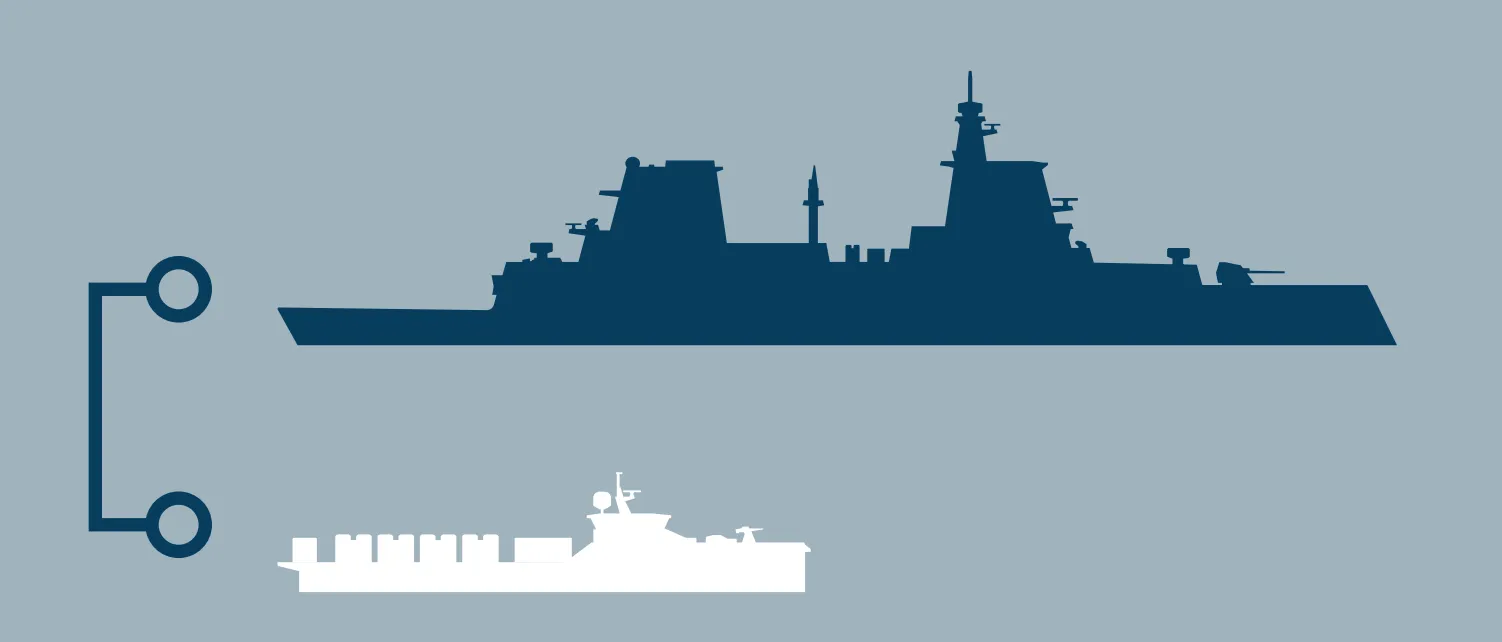Germany To Build Uncrewed Missile-Toting Arsenal Ships For Its Frigates
Germany is the latest country to announce plans for a missile-toting new class of uncrewed vessels that will serve as arsenal ship ‘wingmen,’ supporting conventional surface combatants. The Large Remote Missile Vessels (LRMV) are part of the German Navy’s modernization drive and may be especially relevant to help offset limitations in the firepower of some of its other warships, an issue we have discussed in the past.

The plan to procure three LRMVs is outlined in the German Navy’s Kurs Marine document, which outlines the fleet that it wants to operate by 2035. While the LRMVs will serve as arsenal ships to supplement the new class of F127 frigates, the German Navy also wants to buy 18 smaller uncrewed surface vessels, known as Future Combat Surface Systems (FCSS), to supplement its corvettes, and at least 12 Large Unmanned Underwater Vehicles (LUUV) to support its submarines.

The most striking development, however, concerns the LRMV, which is planned from the outset for uncrewed operations, although presumably they could also be used in an optionally crewed capacity.
It’s not exactly clear what kind of size the LRMVs will be. Presuming a diagram published in the Kurs Marine document is fairly accurate, they would be around half the length of the F127 frigate, which would make them around 260 feet long, roughly corvette-sized. However, according to the German defense and security website hartpunkt, citing naval insiders, the dimensions and displacement of the vessels hadn’t been determined, so not too much should be read into the diagram.

Clearer is the role that the LRMVs will undertake, essentially as floating missile platforms that can bolster the magazine capacity of the planned six F127 frigates, in particular. The arsenal ships will be equipped with vertical launchers for different missiles, to support the F127’s air defense and maritime strike taskings. The number of launch containers is also not yet finalized, hartpunkt reports. Meanwhile, the F127 is expected to feature 64 cells, as part of the popular Mk 41 vertical launch system (VLS).

The VLS cells in the LRMV will likely be loaded with the same weapons that arm the F127 frigate: Standard Missile 2 (SM-2) for general-area air defense and RIM-162 Evolved Sea Sparrow Missiles (ESSM) for short-/medium-range air defense. They could also possibly field SM-6 for long-range air and missile defense, as well as strike, and Tomahawk cruise missiles for longer range strike. SM-6 and Tomahawk would require longer “strike length” VLS cells. The preliminary artwork in the Kurs Marine document shows an array of vertical launchers mounted, at least partly, above the deck at the rear of the ship. However, this should be considered highly provisional.
The German government is currently reviewing a plan to buy the Tomahawk, which would place it in an elite operators’ club. Other options could include the 3SM Tyrfing supersonic cruise naval missile currently being developed by Germany and Norway, and potentially even the new “deep precision strike” weapon, a missile with a range of over 2,000 kilometers (1,243 miles) that Germany and the United Kingdom are working on.

In its air defense role, the ‘parent’ frigate would be responsible for target detection and targeting, commanding missile launches from the smaller LRMV, which will effectively serve as additional floating magazine capacity. This also means the LRMV doesn’t need to accommodate its own expensive sensors. Alternatively, another surface vessel could provide the data, or it could be received from any other platform, with data relayed via satellite link.
Reportedly, the LRMV would also carry some limited self-defense armament, which would presumably have to be controlled from another (crewed) platform.
While seen as a ‘wingman’ to the F127 frigate, it could also complement the anti-submarine-warfare-optimized F126 class of frigates. As we have discussed before, these warships are comparatively lightly armed for their size, with a Mk 41 VLS for up to 64 Evolved Sea Sparrow Missile (ESSM) Block 2 missiles, and launchers for eight Kongsberg Naval Strike Missiles (NSM), but no current plans to arm them with Standard Missiles or Tomahawk.

The LRMV makes an interesting parallel with the two new support vessels planned for the Royal Netherlands Navy. These ships will be around 174 feet long and will displace around 600 tons, including containerized weapons and sensors for a variety of different missions, and a relatively tiny crew. Like the German design, the Dutch support vessels will bring additional air defense missiles to help existing Dutch frigates.

As well as being entirely uncrewed, the LRMV is also intended to operate in very different conditions. While the Dutch support vessel is optimized for use in the North Sea and for patrol duties, the LRMV will be an ocean-going design that can serve in the Atlantic. The German ships will need to have much more robust seaworthiness and will likely need to be considerably larger.

On the other hand, the operating concept for the LRMV foresees them loitering in a specific sea area for an extended period, so they won’t necessarily have to have the same level of performance as the F127 frigate, or an equivalent surface combatant.
While the shipbuilding phase for the LRMV is not necessarily a significant challenge, Germany will still need to develop resilient and reliable command and communications to ensure the ships can operate safely in a potentially highly contested environment. Experience with the Future Combat Surface System (FCSS) program, for a more modest arsenal ship, should help in this regard. Having a lower-cost supplement to the F127 class is also a key consideration, with the new frigates being the most expensive current German defense procurement, with a program cost of more than $30 billion for all six ships.

Overall, Germany’s plans for the LRMV reflect a growing interest in support vessels with an arsenal ship role. These tend to be either uncrewed or with very small crews, and they are indicative of the current operational realities, in which conventional ships threaten to be overwhelmed by massed missile and drone attacks.
The need to boost naval air defense coverage, in particular, has been made clear by the campaign against Houthi missiles and drones targeting shipping in the Middle East in recent months, as well as Iran’s unprecedented, massed attack on Israel, using the same kinds of weapons. In particular, the limited stock of air defense missiles found on most warships has emerged as a concern, and one that the support vessels will help address. Developments elsewhere in the world, including in China, suggest that swarming drones as well as ever more capable missiles will be a feature of naval warfare from now on.
These same concerns are seeing interest in the United States and other countries in large uncrewed surface vessels with modular weapons payloads, allowing them to be adapted for a range of missions as required. While it’s unclear what kind of modularity the LRMV might offer, having an uncrewed ship, even simply to increase the basic weapons magazine available to surface combatants, could be very useful for the German Navy and help pave the way toward more regular and extensive uncrewed operations at sea.
At the same time, there are a lot of unknowns about actually operating an uncrewed ship equipped with heavy armament on operational patrols and over great distances. Command and control and networking architecture will be a huge factor in the success of any such concept. There are also security concerns, clearly. The idea that more naval capacity can be relatively inexpensively gained through uncrewed surface combatants of the larger variety is extremely attractive, but actually doing it reliably is still something that’s yet to be seen on a wide operational scale.
Contact the author: [email protected]





